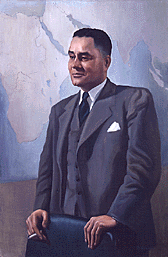Reyneau's portrait suggests Bunche's work in the State Department through the inclusion of a map of Africa and Asia in the background.

Ralph Bunche
Betsey Graves Reyneau
Oil on canvas, 1948
National Portrait Gallery
|
Although Ralph Bunche's success in providing a permanent cease-fire and a peaceful settlement between the Arab and Jewish factions in the Near East in 1949, while simultaneously renewing the world's confidence in the United Nations, were the major vehicles that launched him into the international spotlight and contributed to his receipt of the Nobel Peace Prize in 1950, these were not by any means his only accomplishments. In fact, the Ralph Bunche represented in this painting had as yet to accomplish these feats. In 1948, when Betsy Graves Reyneau completed this portrait, Bunche was best known for his work for the State Department, where he was then associate chief of the Division of Dependent Area Affairs. Bunche had first been approached by the State Department in 1944, after high-ranking officers filed enthusiastic reports on his intelligence work at the outbreak of World War II. Despite his reputation as the foremost authority on colored peoples of the world, Bunche's appointment was opposed because of his racial background. Secretary of State Cordell Hull personally intervened to assure that Bunche was hired, marking the first time in history that an African American had been given a desk-level position in the State Department.
Reyneau's portrait suggests Bunche's work in the State Department through the inclusion of a map of Africa and Asia in the background.
|

Ralph Bunche Betsey Graves Reyneau Oil on canvas, 1948 National Portrait Gallery |